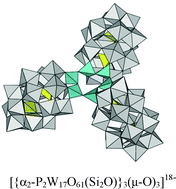The title compound with the formula (Me2NH2)13H5[{α2-P2W17O61(Si2O)}3(μ-O)3]·39H2O Me2NH2-1 was obtained in 12.8% (0.258 g scale) yield by a 1 : 2 molar ratio reaction of α2-mono-lacunary Dawson polyoxometalate (POM) [α2-P2W17O61]10− with SiCl4 in water and unequivocally characterized by complete elemental analysis, TG/DTA, FTIR, (solution and solid-state) 31P NMR, solid-state 29Si NMR and X-ray crystallography. [Note: the moieties of the polyoxoanions in Me2NH2-1 and Me2NH2-2 are abbreviated simply as 1 and 2, respectively.] X-Ray crystallography revealed that the molecular structure of polyoxoanion 1 was a cyclic trimer consisting of three α2-mono-lacunary Dawson POM subunits constituted through intra- and intermolecular siloxane bonds. The compound resulted in an approximate Cs symmetry, but not the idealized C3v symmetry, because one Dawson unit was unequivalently incorporated into the cyclic framework. This compound is the first example of a siloxane-bonding cyclic trimer of POMs and its formation suggests that the oxygen atoms in the lacunary site of POM are reactive just like the surface oxygen atoms of silica. The formation of the cyclic trimer was also clarified by two control experiments: (1) the reaction of [α2-P2W17O61]10− with Si(OEt)4 under acidic conditions (pH 1), and (2) oligomerization under 6 M aqueous HCl acidic conditions (pH∼0) of the reactive monomer units (RMUs: tentatively assigned as “[α2-P2W17O61{O(SiOH)2}]6−”), derived from the cleavage of Ph–Si bonds by the thermal degradation of [α2-P2W17O61{O(SiPh)2}]6−. On the other hand, the reactions of α2-mono-lacunary Dawson POMs with GeX4 (X = OEt, Cl) gave the monomeric species of mono-germanium-substituted Dawson POM (Me2NH2)7[α2-P2W17O61(GeOH)]·5H2O Me2NH2-2, which was characterized by CHN analysis, TG/DTA, FTIR, X-ray crystallography, and (solid-state and solution) 31P NMR spectroscopy. X-ray crystallography revealed that compound Me2NH2-2 was a monomeric species, but the Ge site per formula unit was not determined due to disorder of α-Dawson structure.


 Please wait while we load your content...
Please wait while we load your content...